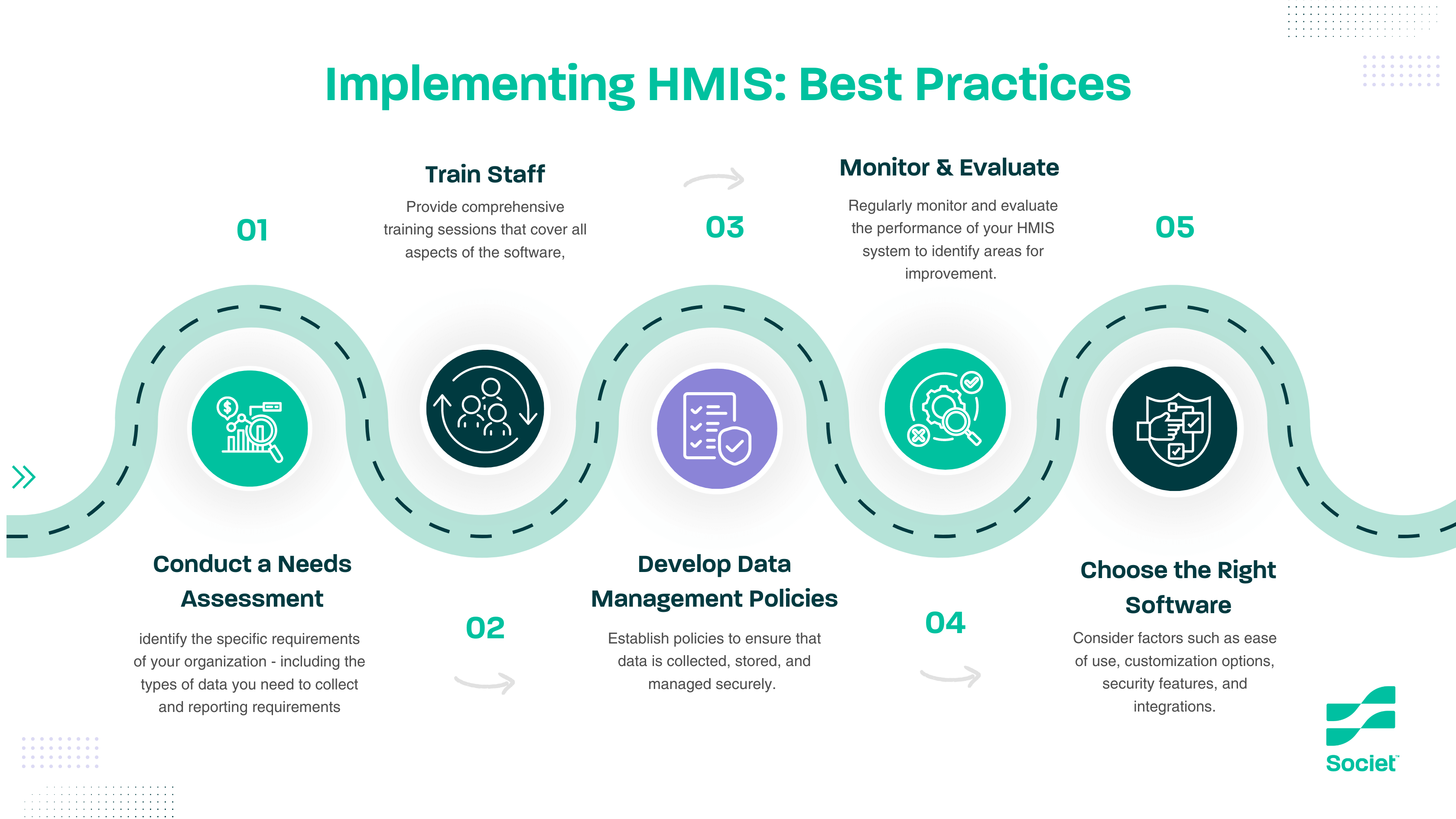
Homelessness is a complex and multifaceted issue that affects millions of individuals and families worldwide. For nonprofits working tirelessly to combat this crisis, effective data management and service coordination are crucial. This is where Homeless Management Information Systems (HMIS) come into play.
What is HMIS?
Homeless Management Information Systems (HMIS) are software applications designed to collect, manage, and report data on homeless individuals and families.
These systems are mandated by the U.S. Department of Housing and Urban Development (HUD) and are used by homeless service providers to track client needs, services provided, and outcomes achieved.
Key Features of HMIS
- Client Tracking: HMIS allows organizations to keep detailed records of each client, including their demographic information, service history, and current needs.
- Service Coordination: These systems facilitate the coordination of services among multiple providers, ensuring that clients receive comprehensive and continuous care.
- Data Reporting: HMIS enables organizations to generate reports on various metrics, such as the number of individuals served, types of services provided, and outcomes achieved. These reports are crucial for funding and compliance with HUD requirements.
- Security and Compliance: HMIS systems are designed to comply with federal regulations like HIPAA and PIPEDA, ensuring that client data is securely stored and managed.
Why HMIS is Essential for Nonprofits
Improved Service Delivery
One of the most significant benefits of HMIS is the ability to improve service delivery. By having a centralized database of client information, service providers can quickly identify the needs of each individual and coordinate appropriate services.
This leads to more effective and efficient care, ultimately improving client outcomes.
Enhanced Data Accuracy
Manual data entry and paper records are prone to errors and inconsistencies. HMIS systems automate data collection and storage, significantly reducing the risk of errors. This ensures that the information used for decision-making and reporting is accurate and reliable.
Better Reporting and Accountability
HMIS systems come with robust reporting features that allow organizations to generate detailed reports on various aspects of their operations.
These reports are essential for demonstrating the impact of services to funders, stakeholders, and regulatory bodies. They also help organizations identify areas for improvement and make data-driven decisions.
Compliance with Federal Regulations
Compliance with federal regulations like HIPAA and PIPEDA is crucial for organizations handling sensitive client information. HMIS systems are designed to meet these regulatory requirements, ensuring that client data is securely stored and managed.
How Sumac Case Management Enhances HMIS
Sumac Case Management is a comprehensive software solution designed to meet the unique needs of nonprofits. It offers a range of features that make it an ideal tool for managing HMIS. Let’s explore how Sumac Case Management can enhance your HMIS efforts.
Streamlined Client Intake
Sumac Case Management simplifies the client intake process, making it easier to collect and store essential information. The software allows you to create custom intake forms that can be filled out online or in person.
This ensures that all necessary information is captured accurately and efficiently.
Centralized Data Management
With Sumac Case Management, all client information is stored in a centralized database. This makes it easy to access and update client records, track service history, and monitor progress.
The software also supports role-based data access, ensuring that sensitive information is only accessible to authorized personnel.
Robust Reporting Features
Sumac Case Management comes with powerful reporting features that allow you to generate detailed reports on various metrics.
Whether you need to report on the number of individuals served, types of services provided, or outcomes achieved, Sumac Case Management makes it easy to create customized reports that meet your specific needs.
Secure Data Storage
Security is a top priority for Sumac Case Management. The software is HIPAA and PIPEDA compliant, ensuring that client data is securely stored and managed. It also offers role-based data access and world-class secure data storage, providing peace of mind that your client information is protected.
Seamless Integration
Sumac Case Management can be easily integrated with other software systems, such as electronic health records (EHR) and financial management systems. This ensures that all your data is seamlessly connected, providing a holistic view of your operations.
For more information on how Sumac Case Management can enhance your HMIS efforts, visit our nonprofit case management software page.
Implementing HMIS: Best Practices
Implementing an HMIS system can be a complex process, but following best practices can help ensure a smooth and successful implementation. Here are some key steps to consider:

Conduct a Needs Assessment
Before implementing an HMIS system, it’s essential to conduct a needs assessment to identify the specific requirements of your organization. This includes understanding the types of data you need to collect, the services you provide, and the reporting requirements you must meet.
Train Your Staff
Proper training is essential to ensure that your staff can effectively use the HMIS system. Provide comprehensive training sessions that cover all aspects of the software, including data entry, reporting, and security protocols. Ongoing training and support are also important to address any issues that may arise.
Develop Data Management Policies
Establish clear data management policies to ensure that all data is collected, stored, and managed consistently and securely.
This includes defining roles and responsibilities, setting data entry standards, and implementing security measures to protect client information.
Monitor and Evaluate
Regularly monitor and evaluate the performance of your HMIS system to identify areas for improvement.
This includes reviewing data accuracy, assessing user satisfaction, and analyzing the impact of the system on service delivery. Use this information to make data-driven decisions and continuously improve your HMIS efforts.
Choose the Right Software
Selecting the right HMIS software is crucial for successful implementation. Consider factors such as ease of use, customization options, security features, and integration capabilities.
Overcoming Common Challenges in HMIS Implementation
Implementing an HMIS system can come with its challenges. Here are some common obstacles and strategies to overcome them:
Resistance to Change
Staff may be resistant to adopting a new HMIS system, especially if they are accustomed to using manual processes or different software. To overcome this, involve staff in the planning and implementation process, provide comprehensive training, and highlight the benefits of the new system.
Data Migration
Migrating data from existing systems to a new HMIS can be a complex and time-consuming process. To ensure a smooth transition, plan the migration process carefully, validate the data to ensure accuracy, and provide training to staff on how to use the new system.
Security Concerns
Handling sensitive client information comes with significant security concerns. Ensure that your HMIS system is compliant with federal regulations like HIPAA and PIPEDA, implement robust security measures, and provide training to staff on data security protocols.
Funding Constraints
Implementing an HMIS system can be costly, and securing funding may be a challenge. To address this, explore various funding options, such as grants and donations, and highlight the long-term benefits of the system to potential funders.
The Future of HMIS
As technology continues to evolve, so too will HMIS systems. Here are some trends and innovations to watch for in the future:
Integration with Other Systems
Future HMIS systems will likely offer even greater integration capabilities, allowing for seamless data sharing between different software systems. This will provide a more holistic view of client needs and services, improving coordination and care.
Advanced Analytics
The use of advanced analytics and artificial intelligence (AI) in HMIS systems will enable organizations to gain deeper insights into their data. This will help identify trends, predict outcomes, and make more informed decisions.
Mobile Accessibility
With the increasing use of mobile devices, future HMIS systems will likely offer enhanced mobile accessibility. This will allow staff to access and update client information on the go, improving efficiency and service delivery.
Enhanced Security Features
As cyber threats continue to evolve, future HMIS systems will likely offer even more robust security features to protect sensitive client information. This includes advanced encryption, multi-factor authentication, and real-time threat detection.
Conclusion
Homeless Management Information Systems (HMIS) are essential tools for nonprofits working to combat homelessness. By providing a centralized database for client information, facilitating service coordination, and enabling robust reporting, HMIS systems help organizations improve service delivery, enhance data accuracy, and comply with federal regulations.
Sumac Case Management is a comprehensive software solution that offers all the features needed for effective HMIS.
From streamlined client intake and centralized data management to robust reporting and secure data storage, Sumac Case Management can help your organization provide the best care for those in need. Book a demo today!
By following best practices for HMIS implementation and staying informed about future trends, your organization can continue to improve its efforts to combat homelessness and provide the best care for those in need.





